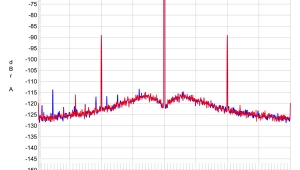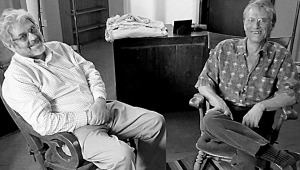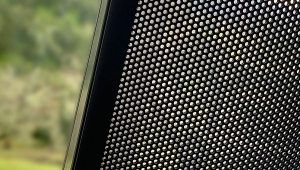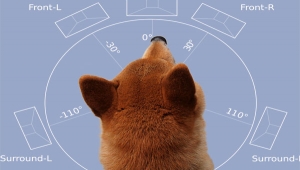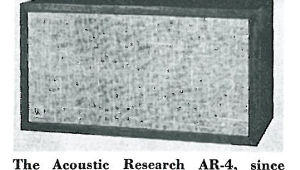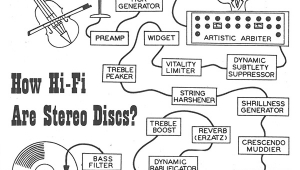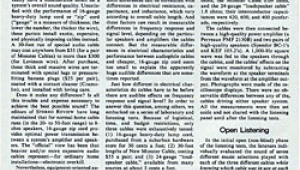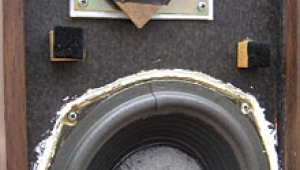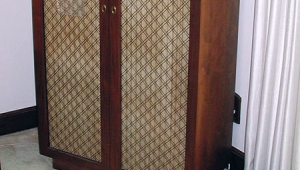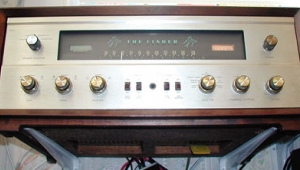| Columns Retired Columns & Blogs |
Watkins WE-1 loudspeaker
First I should clear up what may be an ambiguity in the driver-lineup spec for these speakers. In each system, three 8" cone units serve as woofers. Two of these crossover from the midrange drivers at 100Hz. Crossover to the third 8-incher, the subwoofer, is at 40Hz. Thus, two woofers are active from 100Hz down to 40Hz, and all three are active below 40. In other words, the third woofer does not come into play until the frequency drops to the point where the radiating area of two 8-inchers starts to become inadequate for moving air, at which point the additional area of the third speaker is thrown in. Below 40Hz, all three are working together.
Footnote 1: The BBC dip is not an English ballroom-dance movement, but a broad middle-range frequency-response depression designed into loudspeakers to make them sound farther away from the listener than they actually are. It helped to make the Rogers LS3/5A one of the most popular small speakers ever sold.
This is a big speaker with a big sound. In fact it is physically so large that a lot of people are going to think twice before handing over the domination of their listening room to a pair of them. The WE-1 can put out stupefyingly high volume levels without strain, yet it can reproduce surprisingly well the delicacy and size of a solo guitar, which is a rare accomplishment. Nonetheless, it promises to be a rather controversial system among perfectionists. What the Watkins does well is superb; its defects exist, but their importance will depend on your particular taste on reproduced sound.
For example: At what I would consider to be "comfortable" listening levels, with accurate signal sources, these speakers have a rather soft, closed-in high end. At higher levels, approximating the "right" volume for the material, the ear's increasing sensitivity to high frequencies allows the tweeters to open up, producing one of the most musically natural high ends I have heard for a long time. This is not, however, your usual audiophile-style high-end tizz, but the soft and detailed top one hears from real instruments.
Overall, the WE-1 possesses a rich tonal balance rather than a perfectly accurate tonal balance. (Audiophiles have demonstrated countless times, by their lack of support in the marketplace, that they do not really want accuracy.) It is somewhat polite through the middle range, having had designed into it a little bit of that laid-back BBC dip (footnote 1). Spectral balance and most instrumental timbres are just right, but the system lacks the last degree of snap that puts the music right in the room with you. Lower brasses and piano bass strings are reproduced well but with a certain reticence—a lack of aggressiveness that tends to mitigate the impact of certain kinds of music.

Lower highs—the so-called brightness range—are absolutely superb, without a trace of stridency or steeliness. As a result, massed violins have that rare combination of sweetness and resinous bite that spells realism.
The WE-1 does not cotton to tubed amplifiers we had on hand, especially the EAR 509. Even the Conrad-Johnson Premier I fell short in the lowest bass and high treble. The speaker's bass performance is rather amplifier-dependent; bass from the above-mentioned tubes tends to be too heavy, loose and woolly, with noticeably restricted lowbass range. With good, high-powered (say 200W) solid-state amplifiers, bass from the WE-1s is exceedingly deep and has tremendous impact, but is still oddly undifferentiated, as though it is all being generated by the same kind of (unidentifiable) instrument.
Most tubed amplifiers also make the speaker's normally accurate high end too soft. The EAR 509 (see Vol.6 No.3) made the Watkins' high end too crisp and hard, which in view of the sound of the other tubed amps through it leads me to believe that the WE-1's tweeters or HF crossover may have an impedance anomaly that will cause certain amplifiers to behave in strange and unpredictable ways. (The EARs do not sound bright on anything else we have tried them with.)
Although probably not the only power amps that will work well with the WE-1, the Acoustat TNT-200 and Threshold S/500 were found to be ideal for use with these speakers. (The Acoustat was written up in Vol.5 No.5, and the Threshold review appears elsewhere in this issue.)
Reproduction of depth is not one of the Watkins' strong points, although it does not so much flatten the sound field as compress it somewhat, front to back. The system images well but not stupendously. There is a small amount of vertical-venetian-blind effect with lateral motion of the listener, and while this is not at all severe it is enough to make narrow stereo images a little broad and diffuse, but with good stability (ie, little wandering with changing pitches).
Center imaging is only fair, with mono sources occupying a width of about 10% of the distance between loudspeaker centers. The WE-1s do, however, provide a very wide listening area, from which both good stereo imaging and spread are audible. This makes it a very social system, in the sense that several people can enjoy listening to it at one time instead of having to vie for the privilege of sitting in the "sweet spot." Surprisingly, considering its multiplicity of vertical drivers, the WE-1's sound is practically unaffected by listening height. One can stand or sit without producing more than a very slight change in what is heard from them.
Now that I have picked this speaker to pieces, nit by nit, I should admit that I found it to be one of the most easy-to-listen-to systems I have lived with for a long time. It is not all that forgiving of imperfect input material, yet because there is so little that is musically wrong with its sound, it induces an almost irresistible inclination to ignore the sound and just enjoy the music.
Under the circumstances, it is unfortunate that the word "musical" has become an audiophile pejorative (it now means "euphoniously colored and agreeably veiled"), because musical is exactly what this system is. In fact, this is one of a very small handful of high-priced loudspeakers which I can recommend equally for demanding audiophiles and for affluent music lovers.
The WE-1s can make old and mediocre recordings (late-1960s Columbias, for example) eminently listenable, while making CD playback of no-holds-barred recordings like Telarc's Firebird Suite a hair-raising and quite exhausting experience. The system's ability to project an impression of immense power as well as delicacy and detail is one of its most remarkable and attractive attributes.
To put this system in perspective, its cost is higher than that of most Acoustat models and slightly less than the going Stateside ticket for a pair of Quad ESL-63s. The WE-1 images better than the Acoustats but not quite as well as the Quads. It will reproduce, cleanly, higher signal levels than the Acoustats and substantially higher levels than the Quads. It does not have quite the liquidity or inner detail of these electrostatics, it has relatively less high-end output than either one (but appropriate electronics can make them comparable), but it has deeper, tighter bass than any electrostatic.
Generally, the electrostatics do better reproducing small-scale musical ensembles while the WE-1 is almost unmatched in its ability to render convincingly the power and size of a full symphony orchestra, an operatic production or a solo grand piano at their original levels. (Listening to Mobile Fidelity's trains and thunderstorms on this system is a mindblower!)
Summing up then: The WE-1 is not perfection incarnate, but in my opinion it is an enviable achievement in loudspeaker design, an expensive dynamic system that's well worth its cost.
Note: As this review appears, the Watkins WE-1 remains firmly ensconced as JGH's reference system. In fact, for the first time since my adoption of Stereophile there has been a respite from JGH's recurrent pleas, "It just doesn't sound real," or, "I haven't liked anything I've listened to for months." Instead I hear, "Have you noticed how these grow on you?"—Larry Archibald
Footnote 1: The BBC dip is not an English ballroom-dance movement, but a broad middle-range frequency-response depression designed into loudspeakers to make them sound farther away from the listener than they actually are. It helped to make the Rogers LS3/5A one of the most popular small speakers ever sold.
Footnote 2: This description is much more apt for the Quads than the Acoustats; the Acoustat Models 3, 4, 2+2, 6, and 8 can all produce a very respectable feeling of realism with orchestral material, only slightly less convincingly than the Watkins.
- Log in or register to post comments

